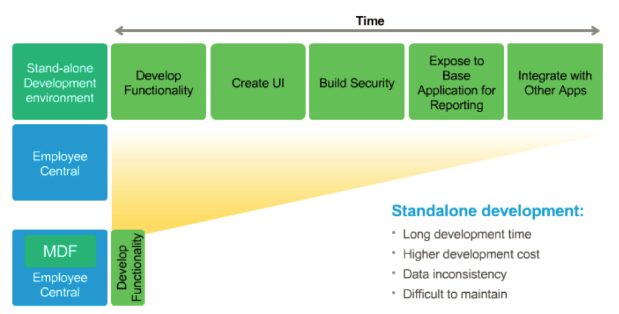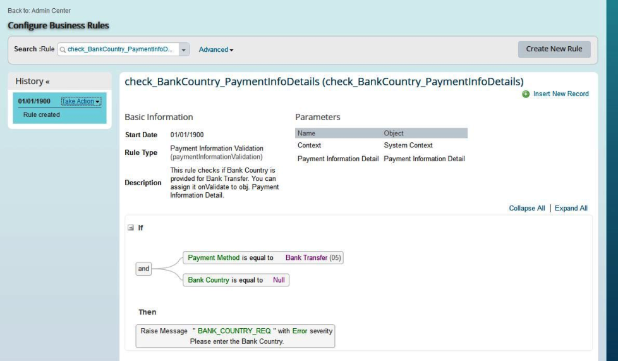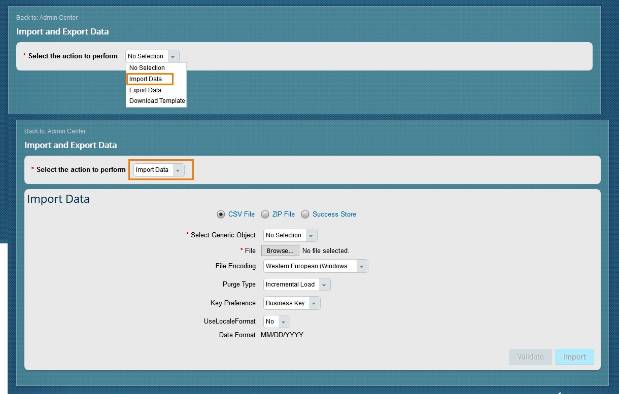At SAP SuccessFactors, we understand that not all functionality can be delivered ‘out of the box’ and that most innovations aren’t delivered through a single vendor. We know that our customers need to evolve with the changing and demanding needs of their business, and we’ve taken Extensibility, a core design principle in software development very seriously. Extensibility enables our customers to deliver new and differentiating capabilities in their organizations.
The Metadata Framework (which we also refer to as MDF) is SAP SuccessFactors robust extensibility framework that enables customers to extend HR cloud functionality to create company-specific objects that support their unique business processes, without the need to code.
The Metadata Framework may be new and unique to SAP ERP HCM customers. In this blog, I will discuss what the Metadata Framework is, and how customers can make the most of it.
The State of the Metadata Framework
The Metadata Framework is used by over 500 SAP SuccessFactors customers to create company-specific and differentiating business processes. The Metadata Framework was built with the understanding that customers want a secure, flexible and robust technology to help them keep up with the demands of their business.

The concept is simple – provide a tool that reduces the time spent to build new capabilities, that empowers other parts of the business, and that enables users to quickly configure the application to meet their business needs.
In the sections below, I’ll attempt to explain who can use the Metadata Framework, and how the Metadata Framework is secure, flexible and robust.
Who can use the Metadata Framework?
Although the name may sound intimidating, the Metadata Framework was built and designed for HR and business analysts to create company specific objects (referred to as Generic Objects within SAP SuccessFactors) without the need to code. Once a Generic Object is created (each one can store up to 200 custom fields!), then HR and business analysts can manage them in the SAP SuccessFactors Admin Center. Rather than requiring technical users to build custom extensions or integrate with a 3rd party application, the Metadata Framework can be used by all business users in an organization to build unique processes in their organizations.
How is the Metadata Framework secure?
Using Role-Based Permissions (RBP), companies can manage who has access to and track who has modified Objects that are created in the Metadata Framework. HR admins are able to track who can create or modify the extensions. Unlike many other applications that require customers to integrate 3rd party applications or plugins to deliver extensibility, customers who use the Metadata Framework are not required to manage the code-base. Company specific objects and screens that are created in the Metadata Framework are unaffected by upgrades or quarterly releases. The performance and stability of SAP SuccessFactors systems is unaffected through the creation of new objects and business processes.
How is the Metadata Framework flexible?
The Metadata Framework features a comprehensive Rules Engine, so that HR and business analysts can apply simple business logic to design rules that are unique to their business. For example, in the image below we have created a business process via the Rules Engine that validates if the bank country is available for payment of services. Business users can create and assign other rules relevant to an employee’s salary, to display warning messages, and to calculate fields on the fly.

How is the Metadata Framework robust?
SAP SuccessFactors built the Metadata Framework so that business users could quickly configure SuccessFactors to extend their unique processes. There is no need to worry about maintaining the code base for test and production use for a large number of users. Company-specific objects created with the Metadata Framework come with out-of-the-box support for OData REST APIs so that customers can quickly create new UIs or integrate them into their existing UIs. Customers can also run reports on objects created in the Metadata Framework without having to manually enter all of the information into the system – the data created from custom objects appears in SAP SuccessFactors systems. Customers are able to import/export data from 3rd party systems systems and store the data in objects created with the Metadata Framework.

What are the advantages of using the Metadata Framework over vis-a-vis custom development?
Basically all of the benefits I have listed above can be summarized here in 4 points:
- Control – Configuration vs. Code. No need to engage technical consultants or vendors. HR admins and business analysts can easily build extensions.
- Speed – Save time, money and effort. Bypass the traditional application development cycle. No technical testing required, only functional testing is needed.
- Consistency – in look and feel. Users experience a familiar UI within SuccessFactors so they don’t require training or time to get up to speed. All users from within SAP SuccessFactors and our customers, partners all experience the same look and feel when they use the Metadata Framework.
- Simplicity – the Metadata Framework is easy to maintain. HR admins can easily add, manage and edit extensions to keep up with the changing demands of their business. Incremental updates and upgrades do not disrupt or affect customer extensions.
How is the Metadata Framework used today within SAP SuccessFactors?
Or asked otherwise – are we drinking our own champagne? The answer is a resounding yes.
SAP SuccessFactors has built applications and extensions such as Employee Central, Position Management, Absence Management, Succession Planning, Talent Pools, Advances/Deductions, Workforce Analytics, and the Job Profile Builder on the Metadata Framework.









